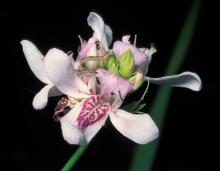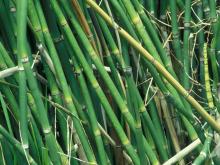Wildflowers, Grasses and Other Nonwoody Plants
Media

Species Types
Scientific Name
Justicia americana
Description
American water willow is common on gravel bars and other stream banks throughout much of Missouri. The dense colonies of emergent stems have leaves like a willow’s, but the two-lipped flowers resemble little orchids.
Media

Species Types
Scientific Name
Viola sororia
Description
The common violet can be violet, white, or white with violet mottling or spots. One of 17 species or violets in Missouri, it occurs statewide in a variety of habitats. Note its heart-shaped or rounded, scalloped leaves, and (usually) the presence of hairs on stems and/or foliage.
Media

Species Types
Scientific Name
Viola pubescens (formerly V. pensylvanica)
Description
The yellow violet is Missouri's only all-yellow violet. This native wildflower is less common than violet violets. Look for it in low woods, rich slopes, and wooded floodplains.
Media

Species Types
Scientific Name
Collinsia verna
Description
The flowers of blue-eyed Mary are only about a half inch wide, but this pretty wildflower makes up for it by usually appearing in abundance, covering a patch of forest floor with little sky-blue and white “faces.”
Media

Species Types
Scientific Name
Lamium purpureum
Description
Dead nettle, like its close relative henbit, is a common, weedy mint that, in early spring, can carpet wide patches of disturbed ground. Recognize dead nettle by the pyramidal look of its purple- or blue-tinted foliage.
Media

Species Types
Scientific Name
Phacelia purshii
Description
An annual, spring-blooming wildflower, Miami mist has loose coils of small blue flowers with distinctive, delicate fringes on the petal lobes.
Media

Species Types
Scientific Name
Houstonia pusilla (H. minima; Hedyotis crassifolia)
Description
Small bluet is a mat-forming winter annual that can color entire lawns blue with its tiny flowers. You can start learning to recognize it by noting the reddish-purple color at the center of the blue-violet flowers.
Media

Species Types
Scientific Name
Viola bicolor
Description
Johnny-jump-up is a flat-faced violet whose small flowers are a washed-out blue or violet with a very light yellow or white center. Look for it in fields, meadows, glades, rights-of-way, disturbed sites, and possibly your front lawn.
Media

Species Types
Scientific Name
Microstegium vimineum
Description
Japanese stiltgrass is an invasive annual grass with thin, pale green, lance-shaped leaves that are 3 inches long. It has spread to nearly every eastern U.S. state. It forms dense patches, displacing and outcompeting native species for nutrients and light.
Media

Species Types
Scientific Name
Equisetum (3 spp. in Missouri)
Description
Horsetails, or scouring rushes, are in the genus Equisetum. They’re easy to recognize with their jointed, hollow stems. Like ferns, they reproduce via spores instead of flowers and seeds.
See Also
About Wildflowers, Grasses and Other Nonwoody Plants in Missouri
A very simple way of thinking about the green world is to divide the vascular plants into two groups: woody and nonwoody (or herbaceous). But this is an artificial division; many plant families include some species that are woody and some that are not. The diversity of nonwoody vascular plants is staggering! Think of all the ferns, grasses, sedges, lilies, peas, sunflowers, nightshades, milkweeds, mustards, mints, and mallows — weeds and wildflowers — and many more!





















